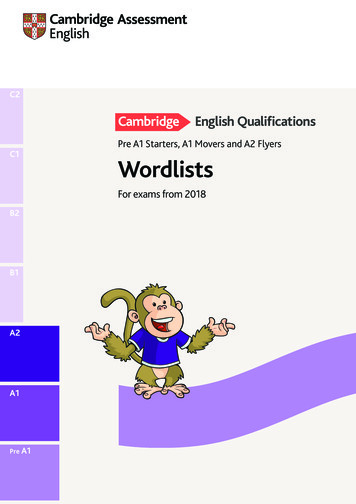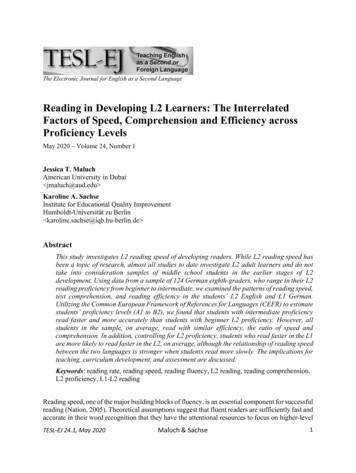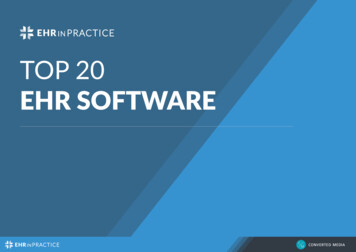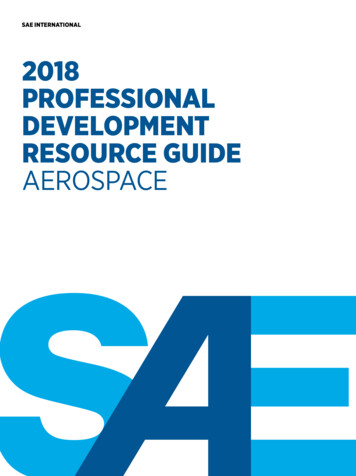
Transcription
2018, 12(2), 129-151Novitas-ROYAL (Research on Youth and Language)A CEFR-based Comparison of ELT Curriculum and CourseBooks used in Turkish and Portuguese Primary SchoolsFatıma Nur FİŞNE1, Müzeyyen Nazlı GÜNGÖR2 ,Luis GUERRA3 & Olga GONÇALVES41MA., English Language Teaching Department, Gazi University, Turkey,fatimanurfisne@gazi.edu.tr2PhD., English Language Teaching Department, Gazi University, Turkey,nazlidemirbas@gazi.edu.tr3PhD., Department of Linguistics and Literature, University of Evora, Portugal,lspg@uevora.pt4PhD., Department of Linguistics and Literature, University of Evora, Portugalobg@uevora.ptSubmissionRevision receivedAcceptanceKeywordsCEFR; ELTcurriculum; A1 levelcourse books;teaching English toyoung learners;language policyAnahtarsözcükler:ADOÇP, İngilizdili öğretimiprogramı, A1seviyesi derskitapları,çocuklara yabancıdil öğretimi, dilpolitikasıArticle information02/05/201812/08/201809/10/2018Abstract: This cross-cultural study aims to explore to what extent a macro-levellanguage policy, the Common European Framework of Reference for Languages(CEFR) (CoE, 2001), is implemented at micro-level contexts, more specifically,primary English classrooms in Turkey and Portugal. This study investigated the 3rdand 4th grade course books and the Turkish and Portuguese English languagecurricula through content analysis and cross-cultural comparison. The course bookanalysis was carried out with reference to language skills as suggested in the CEFR,intercultural characteristics of the course books, and A1 level descriptors. Resultshighlight similarities and differences in both countries in terms of the implementationof the CEFR and representation of A1 level descriptors in course book activities inprimary English classrooms. Implications refer to the importance of teachereducation, preparation of age and inter-culturally appropriate materials for primarylevels and necessities for sustainable and consistent language policy and planning.Türkiye ve Portekiz İlkokullarında Kullanılan İngilizce Dersi Öğretim Programıve Ders Kitaplarının ADOÇP Temelli KarşılaştırılmasıÖz: Bu kültürlerarası çalışma, makro düzey dil politikasının, Avrupa Dilleri OrtakÇerçeve Programının (ADOÇP) (CoE, 2001), mikro düzey bağlamlarda, daha belirginolarak Türkiye ve Portekiz’deki ilkokul İngilizce sınıflarında ne ölçüde uygulandığınıaraştırmayı amaçlamaktadır. Bu çalışma, 3 ve 4. Sınıf ders kitapları ile Türkiye vePortekiz’de kullanılan İngiliz dili öğretim programını içerik analizi ve kültürlerarasıkarşılaştırma yoluyla incelemiştir. Ders kitabı analizi, ADOÇP’da önerilen dilbecerilerine, ders kitaplarının kültürlerarası özelliklerine ve A1 düzeyi tanımlayıcılaragöre gerçekleştirilmiştir. Sonuçlar, ilkokul İngilizce sınıflarında ADOÇP’ninuygulanması ve ders kitabı etkinliklerinde A1 düzeyi tanımlayıcılarının temsiledilmesi açısından iki ülkedeki benzerlikleri ve farklılıkları öne çıkarmaktadır.Öğretmen eğitiminin önemine, ilkokul düzeyi için yaşa ve kültürlerarası özelliklereuygun materyallerin geliştirilmesine, ve sürdürülebilir ve tutarlı dil politikalarının veplanlamanın gerekliliğine yönelik çıkarımlar yapılmıştır.
130Novitas-ROYAL (Research on Youth and Language)Fişne, Güngör, Guerra & Gonçalves1. IntroductionThe macro structure that embodies the English Language Teaching (ELT) national curriculain Europe has been the Common European Framework for Languages (CEFR) since 2001(Jones & Saville, 2009). Morrow (2004) defines the CEFR as “a means of developinglanguage teaching in Europe by finding a way to compare the objectives and achievementstandards of learners in different national contexts” (p. 7). More specifically, it serves as adetailed map for teachers, curriculum developers, and course designers to improve currentpractices by adapting the ideas and resources set out in the framework. It is a product of theCouncil of Europe (CoE) that began in the late 1950s. Now, it groups together 47 countriesincluding Turkey and Portugal (Morrow, 2004). It is referred to and implemented in theelaboration of language syllabuses, curriculum guidelines, examinations and materialsdevelopment across Europe. However, as many studies reveal (Jones & Saville, 2009;Martyniuk & Noijons, 2007; Nakatani, 2012), the full potential of the framework at theclassroom level has not been realized yet because understanding to what extent it has beenimplemented in the course books and how teachers are equipped with its guidelines haveremained difficult. Accordingly, the purpose of this cross-cultural study is to gain insightsinto the extent to which the CEFR is implemented in the English Language Teachingsyllabuses and course books for the 3rd and 4th primary grades in Portugal and Turkey.1.1. The English Language Teaching Reforms and Policies in Turkey at Macro- andMicro- LevelsIn 2012, the Turkish Ministry of National Education (MoNE) launched the latest regulation of4 4 4 education system. According to this education system, primary, secondary and highschool education each lasts for 4 years adding up to 12 years (Bayyurt, 2014; Kırkgöz, 2014).The starting age for learning English as a foreign language in Turkey was reduced to 7 in thesecond grade from 9 in the fourth grade in Turkey (Demirezen, 2014). The amount of Englishlessons was defined as 2 hours during the first three years, then to 4 hours during the rest ofthe four years. In other words, primary graders started learning a new foreign language at anearlier age as in other European countries like Hungary and Spain as well as in China andJapan (Nunan, 2003). Such a reform brought about a new and updated teaching program withnew syllabuses for the 2nd and 3rd grades and revised syllabuses from the 4th to 8th grades(Güngör, 2016). In line with this revision (MoNE, 2013), mainly speaking and listening skillsare emphasized in the 2nd and 3rd grades while reading, writing and grammar are integratedin the following grades. In the 5th and 6th grades, young learners are exposed to short textsand controlled writing activities while 7th and 8th graders read simple texts and write shortparagraphs.The Ministry of National Education also decided to modify the 2013 curriculum with regardsto the latest reform movement for grades 2, 3, 4 and onwards in 2017 (MoNE, 2017). Thismodification proposed an action-oriented approach and other instructional techniques likeTotal Physical Response, art and crafts, drama, role-plays, songs, games, and cognates(MoNE, 2017). The updated curriculum was revised in two ways: the first one was throughthe integration of values into education, basic skills as themes and means of assessment andevaluation, and the second one was by way of the linguistic realization of target languageskills, evaluation of the tasks and activities and analysis of the program with respect to formsand functions. Moreover, the CEFR served as a basis for the selection of cultural and familiarthemes such as family, holidays, leisure time activities to increase young learners’ tolerancetowards cultural differences. In addition, the amount of English lessons was reduced to 3hours in the 5th and 6th grades, while it remained unchanged in the other grades. As forassessment and evaluation, the new syllabus suggested performance evaluation through a listof self-assessment questions like “how much did you learn?”, “what did you learn?” and
131Novitas-ROYAL (Research on Youth and Language)Fişne, Güngör, Guerra & Gonçalves“what do you think you can do in real life based on what you learnt in class?” Also, younglearners were required to keep a dossier of their language learning achievement as mentionedin the European Language Portfolio (MoNE, 2013). Apart from self-assessment and thedossier, formal exams were suggested through oral and written examinations, quizzes,homework assignments, portfolios, projects, teacher observation and peer-evaluation(Güngör, 2016). Finally, each English language program was constructed upon the previousone to sustain learner outcomes through enjoyable learning atmosphere and topics (Kırkgöz,2014).The revised program employs an action-oriented approach in which English is used as amedium of communication through classroom interactions to communicate competently. Thisapproach has been adopted from the CEFR and aims to achieve autonomy, self-assessmentand appreciation for cultural diversity. Learners are expected to become confident andproficient users of English and appreciate their own culture as well as international cultures.The underlying notion is that young learners learn best through songs, games and hands-onactivities (Pinter, 2017); therefore, it serves as a guideline to facilitate young learners’learning process through authentic materials, drama, role-play and similar enjoyable andmotivating activities. The program aims to reach out to learners in diverse populations atdifferent developmental levels to meet their needs successfully (MoNE, 2017). Although theemphasis is on speaking and listening activities in the first three grades of the program,teachers are also given space to practice doable reading and writing activities based on thenotion of a communicative classroom. While the program contains suggestions and sampleunits for the book authors, there are also suggestions for teachers. They are expected tointroduce the tasks, activities and contexts that are relevant and appropriate for learners’ lives.Teachers are to perform teaching by considering varied learning strategies for both classroominstruction and assignments regardless of the one-sided strategy preference for examinations(MoNE, 2017).From a broad perspective, the program offers some key competences which include basicskills each and every citizen needs to acquire in formal education (CoE, 2001). Thesecompetences are communicating in the native and target language, developing literacy, mathand science skills, learning to learn, taking social and civic responsibility, taking initiative,being an entrepreneur, and developing cultural awareness and creativity. The themes andtopics were revised so as to cover these competences and values in education so that teacherscould make appropriate contextual choices and supplementary materials. Hence, the programoffers teachers specific suggestions. In other words, it is left to teachers to decide on thespecific selection of teaching methods and techniques to meet learners’ linguistic, social andcognitive needs. Teachers are given the authority to focus on the values and key competencesunderlying the units through themes and topics. As Bayyurt (2014) suggests, rather than thecourse hours at primary levels, the important thing is spending the English lesson hourseffectively. Hence, teachers should be provided with well-prepared teaching materials and usethem effectively enough for the learners’ developmental, social and emotional needs (Tüm &Parmaksız-Emre, 2017).1.2. The English Language Teaching Reforms and Policies in Portugal at Macro-andMicro- LevelsThe decision of the Portuguese government to include the teaching of English in primaryschools came as a direct consequence to the political statements and the multiple documentsand reports issued by the European institutions since the last decade of the 20th century whichaimed at a set of measures to foster the acquisition of foreign language skills in general,particularly, of the English language. Although the European recommendations regarding theteaching of languages are not prescriptive as to which languages to teach, and it promotes
132Novitas-ROYAL (Research on Youth and Language)Fişne, Güngör, Guerra & Gonçalveslinguistic and cultural diversity, the choice to provide the acquisition of English in primaryeducation in Portugal seemed natural due to the current role of English as the main languageof international communication. Consequently, until the academic year 2012/2013, Englishwas taught as an ‘Extra-Curricular Activity’ in Portuguese primary schools (1st cycle)1,offered mandatorily by the schools but as an elective subject**. However, in 2014, Englishbecame a mandatory subject in years 3 and 4 commencing in the academic year 2015/2016,thus ensuring the offer of seven consecutive years (years 3 to 9) of English language learningin Portugal.At present, the English language curriculum and syllabus for primary school/1st cycle aredeveloped based on a set of 3 major documents: the ‘Curricular Aims for English LanguageTeaching’ - CAELT (Bravo, Cravo, & Duarte, 2015), the ‘Supporting Materials for theCurricular Aims for ELT in Primary Education’ - SMCAEPE (Cravo, Bravo, & Duarte,2015), and the ‘Programming Guidelines for Teaching English in Primary Education:Teaching and Learning Materials’ - PGTEPE (Bento, Coelho, Joseph, & Mourão, 2005),produced by the Ministry of Education aiming at providing relevant and detailed informationabout teaching English in primary education/1st cycle (years 3 and 4) which should be used aspractical guidelines by the two major agents of action, namely English for Young Learners(EYL) teacher education programs at universities and EYL materials producers at Portuguesepublishing houses.To all intents and purposes, the CEFR is perhaps the most important influence on the drawingup of those documents. Firstly, the CAELT (Bravo et al., 2015) identifies the correspondencebetween the CEFR competence level A1 (Basic User) and Years 3 and 4 of primary school (p.2). Furthermore, it provides a detailed list of language competences to be developed bylearners in both years of the 1st cycle in the following domains: Listening, Reading, SpokenInteraction, Spoken Production, Writing, Intercultural Domain, and Lexis and Grammar (p. 418). Similarly, the SMCAEPE reinforces the importance of the CEFR by organizing thecontent of the proposed activities based on the following domains of reference categorized inthe CEFR: Intercultural Domain, Lexis and Grammar, Listening, Spoken Interaction, SpokenProduction, Reading and Writing. Moreover, it recommends activities which foster theacquisition of the A1 level, as proposed by the CEFR (p. 3). Finally, the PGTEPE (Bento etal., 2005), in its ‘Framework’ section, recognizes it has been structured based on the CEFR’sessential nature to promote the development of plurilingual and pluricultural awareness (p. 9).1.3. The CEFR and Young Learners’ Curricula and Course BooksYoung learners have captured the attention of literature recently. According to Pinter (2017),primary language teaching materials should provide learners with the opportunity and spaceto develop their cognitive skills, metalinguistic awareness and communication skills inEnglish, encourage enjoyment and motivation, and learn about other cultures. They shouldhave age-specific characteristics which affect foreign language learning such as learning bydoing, interacting with others, and learning through a role model (Cameron, 2012; Crandall &Shin, 2014). At the same time, considering the cognitive, emotional and physicaldevelopments of young learners, it is vital to apply these considerations to the Englishlanguage classroom through appropriate techniques, recommendations and practices withmaterials (Güngör, 2016). Similarly, the CEFR has brought curriculum, pedagogy andassessment into a closer interdependence (Little, 2011), mostly owing to the action-oriented1The Portuguese educational system is structured in the following way: Basic Education (Years 1 to 9), divided into 1st cycle(years 1 to 4), 2nd cycle (years 5 and 6), and 3rd cycle (years 7 to 9); Secondary Education (years 10 to 12).**English is taught mandatorily from years 5 to 9 (2nd and 3rd cycles).
133Novitas-ROYAL (Research on Youth and Language)Fişne, Güngör, Guerra & Gonçalvesapproach to describe L2 proficiency. Each “can-do” descriptor is used to specify and developthe learning target activities, materials, and assessment types.However, as Little (2011) warns, the extent to which the curricula and course books areprepared to reflect those principles should be clearly examined. In short, it is important toevaluate curriculum and course books developed for young learners in terms of reflecting theprinciples of the underlying theory, meeting the developmental needs of young learners, andleading teachers to apply developmentally appropriate teaching methods and/or techniques(Ghosn, 2013; Tomlinson, 2013). Furthermore, the adaptation of the CEFR entails a processof contextualization and appropriation (Little, 2011). There are several studies which focus onthe implementation of the CEFR in 2nd grade course books (Tüm & Parmaksız-Emre, 2017),in 8th grade course books through a critical discourse analysis perspective (Balcı, 2017), andin the 2nd grade ELT curriculum through illuminative evaluation model (Özüdoğru, 2016) inTurkey which focus on the comparison of ELT curriculum in Portugal and Kosovo (Bekteshi,2017); however, there is little emphasis on the comparative studies conducted in bothcountries that use the CEFR as their map in the ELT curriculum at macro-and micro-levels.Hence, this study aims to compare ELT curricula and course books employed in younglearners’ classrooms in the 3rd and 4th grades in Turkey and Portugal in view of the keyaspects of the CEFR. To this end, it attempts to explain to what extent ELT curricula andcourse books in each country follow the principles of the CEFR. Following that, the twocountries will be compared in accordance with their coverage of the CEFR in primaryschools.2. Method2.1. Research QuestionsBased on the aims of the study, the research questions below guided the analysis of data:(1) To what extent does the ELT curriculum used in young learners’ classrooms in Turkeyand Portugal reflect the main considerations of the CEFR?(2) To what degree do ELT course books employed in the 3rd grade and 4th grade follow thedescriptors of the major skills for A1 level emphasized in the CEFR?2.2. Research DesignIn this study, a mixed research methodology has been employed to examine the curricula andcourse books thoroughly. Dörnyei (2007) defines the mixed method as a “collection oranalysis of both quantitative and qualitative data in a single study with some attempts tointegrate the two approaches at one or more stages of the research process” (p. 163). Creswell(2014) specifies basic and advanced mixed method research types with respect to datacollection, analysis and interpretation. Accordingly, this study draws upon a “convergentmixed methods design” in which the researchers “compare or relate” the results of qualitativeand quantitative data analyzed separately (Creswell, 2014, p. 220). In this research, qualitativeand quantitative data were gathered and analyzed separately. The findings obtained from bothkinds of data were interpreted and related in order to track the implementation of the CEFRrespectively in ELT curriculum and course books. For qualitative data collection, a“Curriculum Evaluation Form” was used to investigate the representations of the CEFR inELT curriculum in Turkish and Portuguese primary schools. On the other hand, quantitativedata were gathered through “The CEFR Checklist for A1 Level Course Books” providing fullfledged analysis of the 3rd Grade and 4th grade course books in view of main language skills(i.e., spoken production, reading comprehension, written production, listening comprehension,and spoken interaction).
134Novitas-ROYAL (Research on Youth and Language)Fişne, Güngör, Guerra & Gonçalves2.3. Data Collection ProcedureFirstly, the “Curriculum Evaluation Form” was employed to examine the curriculardimensions of English language teaching in primary schools. This form was developed by theresearchers to measure to what extent ELT curriculum in Turkey (MoNE, 2017) and ELTcurriculum in Portugal (Bravo et al., 2015; Cravo et al., 2015) meet the requirements of theCEFR in foreign language education in primary schools. In order to devise this instrument,theoretical aspects of the CEFR given below were taken into consideration as the constructsof the data collection form:Language teaching approach(es), language teaching and learning materials, language skills,language functions, contextual domains, task conditions and constraints, and languageassessment and evaluation (CoE, 2001).In consonance with these constructs, open-ended and close-ended questions were written, andthen expert opinions were asked about the content validity of these questions. Upon thefeedback obtained from the field experts, the “Curriculum Evaluation Form” was revised andfinalized for the actual administration (see Appendix A). Each pair of researchers examinedtheir own national curriculum in practice since they are more acquainted with the contextualinformation about teaching English to young learners in their native country.Secondly, the CEFR checklist for A1 level course books was used to develop anunderstanding of how comprehensively ELT course books for the 3rd and 4th grades reflectA1 level descriptors (can-do statements) given in the CEFR for the five main skills (CoE,2001). By and large, this checklist measures to what degree the course books present younglanguage learners with activities which are constructed in line with A1 level descriptors.These descriptors provided a basis for the development of each item in the checklist.Checklist items were examined by five experts to ensure the content validity. In light of theexpert feedback, the CEFR checklist was reviewed and prepared for the course book analysis.Through this finalized checklist (see Appendix B), the following course books (see Table 1)were analyzed by the researchers:Table 1Descriptive information about the target course books used in the analysisCountryGradeCourse BooksWriters & Publishing YearTurkey3rd Gradeİlkokul İngilizce 3: Ders Kitabı(Dağlıoğlu, 2017)4th Gradeİlkokul İngilizce 4: Ders Kitabı(Barut, 2017a; 2017b; 2017c)3rd GradeLet’s Rock! 3(Abreu & Esteves, 2017a)4th GradeLet’s Rock! 4(Abreu & Esteves, 2017b)PortugalThe Turkish course books, which were officially approved by the board of education andemployed by English language teachers in the 3rd and 4th grades across the country, weredeveloped by the course book writers in keeping with the curricular underpinnings of ELTcurriculum (MoNE, 2017) used in primary schools in Turkey. Similarly, the Portuguesecourse books were developed by material writers in line with the guidelines proposed by theMinistry of Education (Bento et al., 2005; Bravo et al., 2015; Cravo et al., 2015) in relation toEnglish language teaching in primary schools. Those course books were analyzed in threestages as shown in Figure 1.
135Novitas-ROYAL (Research on Youth and Language)Fişne, Güngör, Guerra & GonçalvesFigure 1. Three stages of the course book analysis through the CEFR checklist1. Target course bookswere exchanged byresearchers to conduct anobjective analysis.2. A follow-up analysis ofcourse books was carriedout by one of theresearchers individually.3. All analysis resultswere compared, andcourse book activitiesdeveloped on the basis ofthe CEFR werecategorized for each skill.In the first stage, the abovementioned course books were exchanged among the Portugueseand Turkish researchers and analyzed activity by activity. As a second step, a follow-upanalysis of the course books was conducted by one of the researchers independently. At thesestages, it is attempted to secure both inter-rater and intra-rater reliability. For inter-raterreliability, the researchers worked in collaboration to develop an agreement on the placementof each language activity into the appropriate checklist item. In regard to intra-rater reliability,which refers to a researcher’s elaboration on data in “the same way at different times”(Mackey & Gass, 2005, p. 129), one of the researchers analyzed the course book activitiesthoroughly (Stage 2) at different intervals from various perspectives. Finally, all analysisresults were compared, and course book activities which were appropriately constructed inlight of the CEFR were highlighted in each language skill.During the course book analysis, some important points were taken into consideration asexplained below.§ Figures, flags, traditions from various countries and different characters, which do notexist in the native cultures, are regarded as cultural elements of the course books.§Course book activities based on “making a dialogue” or “making a sentence” wereexamined to analyze both speaking and writing skills.§Song and chant activities, even if some of their transcriptions were not available, wereseen as authentic and practical listening and speaking activities because the pupils canmake use of songs or chants easily to develop their receptive and productive skills.§Authenticity was also traced in listening and reading activities including cartoons andspeech bubbles.§Each activity developed for spoken interaction was considered as a spoken productionas well.§A set of sentences, which consists of at least ten words, was accepted as a short textfor reading comprehension.§When some mechanical activities were dependent on a core activity in practice, onlythe core activity was taken into account in the course book analysis.§Course book activities presented in a postcard-shaped or post-it-shaped figures wereanalyzed as if they were given in a separate material like real postcard or post-it.§Grammar-based activities which required the pupils to fill in the blanks withappropriate structure were accepted as writing practices.§Spelling activities were not analyzed within the framework of the writing skill since itis regarded as an orthographic skill in the CEFR (CoE, 2001).§Because of practical issues in getting audio and video files in the target countries,some listening and video activities were not included in the course book analysis.
136Novitas-ROYAL (Research on Youth and Language)Fişne, Güngör, Guerra & GonçalvesIn addition, some items (the third item in listening comprehension, and the second and tenthitems in spoken interaction) in the checklist were excluded from the course book analysis dueto the limitations of the study (see Appendix B). More specifically, the researchers could notreach the audio files of target course books because of the practical reasons. Whereas a largemajority of listening comprehension activities can be analyzed with their transcription andvisuals provided, the third item in the listening comprehension part of the CEFR Checklist(i.e., the course book presents students with activities which include very slow recordingswith long pauses) requires the researchers to access the audio files. Similarly, the researcherscan interpret the second and tenth items in the spoken interaction part only by taking part inclassroom practices and observing spoken interaction among the students, while other items inthis part can be checked with reference to the examples, visuals, and instructions given in therelevant activities. Because of those limitations of the study, the abovementioned items werenot included in the analysis of course book activities, and they were not reported in the“Results” section.In keeping with the high-stake points identified above, Table 2 summarizes the number ofactivities which were analyzed in each course book. As it is obvious, Portuguese course booksinclude more activities when compared with Turkish course books.Table 2Number of course book activities analyzed through the CEFR ChecklistTurkey3rd GradePortugal4th Grade3th Grade4th Grade1.Spoken Production647384662.Reading Comprehension11311301033.Written Production152385594.Listening Comprehension311149385.Spoken Interaction33352623Total1541733742892.4. Data AnalysisSince qualitative and quantitative data were collected independently and respectively from the“Curriculum Evaluation Form” and “The CEFR Checklist for A1 Level Course books,” bothtypes of data were analyzed separately. In order to code and categorize the qualitative datagathered through open-ended questions, content analysis was employed. This analysistechnique is based on “the process of summarizing and reporting written data – the maincontents of data and their messages” (Cohen, Manion, & Morrison, 2007, p. 475). Along withthe content analysis, descriptive statistics were computed for quantitative data collected withthe checklist items. “Descriptive statistics can help to provide simple summary or overview ofthe data, thus allowing researchers to gain a better understanding of data set” (Mackey &Gass, 2005, pp. 250-251). Accordingly, frequencies and percentages were calculated topresent to what degree the activities in the 3rd grade and 4th grade course books in Turkeyand Portugal reflect the can-do statements for each language skill at A1 level in the CEFR.3. ResultsThe results reveal the basis of two main constructs: the implementation of the CEFR in ELTcurriculum and representation of the CEFR descriptors in ELT course books at A1 level.
137Novitas-ROYAL (Research on Youth and Language)Fişne, Güngör, Guerra & GonçalvesFirstly, both curricula were evaluated in terms of their coverage of the CEFR underpinnings.Following that, the 3rd and 4th grade course books were described with respect to theirpercentage of representing A1 level descriptors in the CEFR.Implementation of the CEFR in ELT CurriculaELT curricula used in foreign language education in Turkish and Portuguese primary schoolswere thoroughly evaluated in consideration of the key components emphasized in the CEFR.Table 3 draws a holistic framework of how the CEFR components are elaborated in ELTcurricula in both countries:Table 3Evaluation of ELT curriculum in Turkey and Portugal in view of the CEFRTurkey*SuggestedApproachComponentsLanguage nTask Conditionsand ConstraintsTeaching orLearningMaterialsAssessment andEvaluationAn eclectic mixture of instructionaltechniques on the basis of action-orientedapproachGeneral Objectiv
and 4th grade course books and the Turkish and Portuguese English language curricula through content analysis and cross-cultural comparison. The course book analysis was carried out with reference to language skills as suggested in the CEFR, intercultural characteristics of the course










